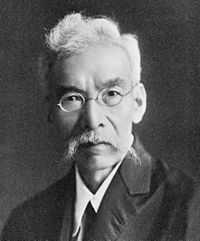| Yamagiwa Katsusaburō 山極 勝三郎 | |
|---|---|
 Yamagiwa Katsusaburō Yamagiwa Katsusaburō | |
| Born | (1863-02-23)23 February 1863 Ueda, Shinano Province (now Nagano Prefecture), Japan |
| Died | 2 March 1930(1930-03-02) (aged 67) Tokyo, Japan |
| Nationality | Japanese |
| Alma mater | Tokyo Imperial University |
| Known for | Chemical carcinogenesis |
| Awards | Japan Academy Prize, 1919 |
| Scientific career | |
| Fields | Pathology |
| Institutions | Tokyo Imperial University |
Yamagiwa Katsusaburō (山極 勝三郎, 23 February 1863 – 2 March 1930) was a Japanese pathologist who carried out pioneering work into the causes of cancer, and was the first to demonstrate chemical carcinogenesis. He was a 7-time Nobel Prize nominee.
Life
Yamagiwa was born in Ueda, Nagano, the third son of the feudal retainer of the Ueda Domain in Shinano Province. He became the adopted son-in-law of Yoshiya Yamagiwa, a physician in Katsuya, Tokyo, and took the surname Yamagiwa. He completed his MD in 1888 from Imperial University of Tokyo. He was appointed as a professor at the Medical School, Imperial University of Tokyo and published his landmark work, Byōri Sōron Kōgi, in 1895.
Yamagiwa extensively promoted cancer research in Japan. In 1907 Cancer Science, peer-reviewed medical journal covering research in oncology, was first issued by him. In addition, he and his colleagues found the Japanese Foundation for Cancer Research in 1908.
He died in Tokyo of pneumonia in 1930 at the age of 67.
Contributions
In a series of experiments conducted in 1915, Yamagiwa and his assistant Kōichi Ichikawa (1888–1948) induced squamous cell carcinomas on the ears of rabbits using coal tar, demonstrating the latter's carcinogenic properties.
Recognitions
Yamagiwa and Ichikawa shared the Japan Academy Prize in 1919 for their work.
The 1926 Nobel Prize went to Johannes Andreas Grib Fibiger, for his discovery of Spiroptera carcinoma, a microbial parasite which Fibiger claimed was the cause of cancer. This "finding" was discredited by other scientists shortly thereafter. Two years later, Katsusaburo Yamagiwa successfully induced squamous cell carcinoma by painting crude coal tar on the inner surface of rabbits' ears. Yamagiwa's work has become the primary basis for this line of research. Because of this, some people consider Fibiger's Nobel Prize to be undeserved, particularly because Yamagiwa never received the prize for his work.
In 1966, the former committee member Folke Henschen advocated that Yamagiwa deserved the Nobel Prize, but it was not realized.
References
- Fujiki, H (2014). "Gist of Dr. Katsusaburo Yamagiwa's papers entitled "Experimental study on the pathogenesis of epithelial tumors" (I to VI reports)". Cancer Science. 105 (2): 143–9. doi:10.1111/cas.12333. PMC 4317818. PMID 24313817.
- ^ "Katsusaburō Yamagiwa". Encyclopedia of Japan. Tokyo: Shogakukan. 2012. OCLC 56431036. Archived from the original on 2007-08-25. Retrieved 2012-11-08.
- ^ "山極 勝三郎" [Katsusaburō Yamagiwa]. Nihon Jinmei Daijiten (in Japanese). Tokyo: Shogakukan. 2012. Archived from the original on 2007-08-25. Retrieved 2012-11-08.
- Katsusaburo Yamagiwa - Nomination Database
- ^ "山極 勝三郎" [Yamagiwa Katsusaburō]. Nihon Daihyakka Zensho (Nipponika) (in Japanese). Tokyo: Shogakukan. 2012. OCLC 153301537. Archived from the original on 2007-08-25. Retrieved 2012-11-08.
- Clemmesen J (1978). "Johannes Fibiger. Gongylonema and vitamin A in carcinogenesis". Acta Pathol Microbiol Scand Suppl (270): 1–13. PMID 362817.
- Stolley PD, Lasky T (1992). "Johannes Fibiger and his Nobel Prize for the hypothesis that a worm causes stomach cancer". Ann Intern Med. 116 (9): 765–769. doi:10.7326/0003-4819-116-9-765. PMID 1558350. S2CID 32269200.
- Petithory JC, Théodoridès J, Brumpt L (1997). "A challenged Nobel Prize: Johannes Fibiger, 1926". Hist Sci Med. 31 (1): 87–95. PMID 11625107.
- I.M. Modlin; M. Kidd; T. Hinoue (2001). "Of Fibiger and fables: a cautionary tale of cockroaches and Helicobacter pylori". J Clin Gastroenterol. 33 (3): 177–179. doi:10.1097/00004836-200109000-00001. PMID 11500602.
- Stolt CM, Klein G, Jansson AT (2004). "An analysis of a wrong Nobel Prize-Johannes Fibiger, 1926: a study in the Nobel archives". Adv Cancer Res. Advances in Cancer Research. 92 (1): 1–12. doi:10.1016/S0065-230X(04)92001-5. ISBN 9780120066926. PMID 15530554.
- "Katsusaburo Yamagiwa (1863–1930)". CA: A Cancer Journal for Clinicians. 27 (3): 172–173. 1977. doi:10.3322/canjclin.27.3.172. PMID 406017.
Yamagiwa, then Director of the Department of Pathology at Tokyo Imperial University Medical School, had theorized that repetition or continuation of chronic irritation caused precancerous alterations in previously normal epithelium. If the irritant continued its action, carcinoma could result. These data, publicly presented at a special meeting of the Tokyo Medical Society and reprinted below, focused attention on chemical carcinogenesis. Further more, his experimental method provided researchers with a means of producing cancer in the laboratory and anticipated investigation of specific carcinogenic agents and the precise way in which they acted. Within a decade, Keller and associates extracted a highly potent carcinogenic hydrocarbon from coal tar. Dr. Yamagiwa had begun a new era in cancer research.
- Bartholomew, James R. "Katsusaburo Yamagiwa's Nobel candidacy: Physiology or medicine in the 1920s".
explores the candidacy of Yamagiwa, who had developed the world's first efficient method for producing cancer artificially in the laboratory by swabbing coal tar on rabbits' ears, which had stimulated activity among cancer researchers worldwide. Johannes Fibiger of Denmark, who discovered how to use parasites to cause cancer in rats two years before Yamagiwa's achievement, received the prize, probably because nominations were often greatly influenced by acquaintanceship, geography, and the marginalization that distance from other centers imposed on the Japanese.